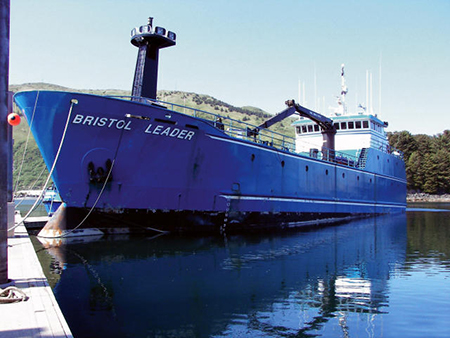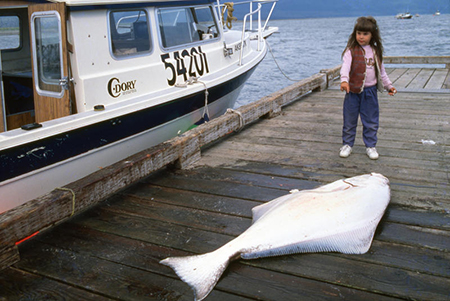Alaska Fish & Wildlife News
November 2019
Guest Commentary: State has multi-year plan
for fisheries priorities on federal council

Alaska’s federal fisheries for halibut, cod, pollock, flatfish, mackerel, sablefish and rockfish are economically important, both on a state and national level.
They form the cornerstones of the economies of many of our coastal communities and provide numerous jobs at the fishing, processing and transportation/shipping levels. Through exports they provide a source of nutrition worldwide. As a result, decisions regarding their management are critically important to our state.
Alaska shares management responsibilities for federal (3 to 200 miles) fisheries with the federal government. Decisions regarding the management of these fisheries are made via the North Pacific Fishery Management Council. This Council has 11 voting seats, of which 6 are nominated by the State of Alaska. As a result, Alaska has the opportunity to focus the work of the council on issues of import to our state and its fishermen and communities.
We have spent the past several months speaking with a diverse range of user groups, delegations from our coastal communities, fishermen, processor representatives and other Alaskans to assess the issues facing them.
These discussions were valuable, identifying not only the issues, but also in identifying priorities and potential solutions. Based on our discussions it is clear that many issues exist. Fortunately, we also found a willingness by many to roll up their sleeves and put in the hard work to resolve these issues.
Based on these discussions we plan to focus our collective efforts in the council over the next several years on several areas, each of import to fishery participants and our coastal communities.
First is to resolve long-standing issues related to the observer program for groundfish and halibut fisheries. It is critical that managers continue to have a robust observer program that provides high quality data for stock assessments and fisheries management.
But the program needs to be affordable and minimize impacts on fishing and processing operations. As technologies improve, we need to better incorporate electronic monitoring systems into the program. Finding the right mix will be challenging but is critical towards ensuring catches and bycatch are accurately monitored and established limits are enforced in a manner that is economically viable for fishery participants.
We also plan to focus our attention on developing a comprehensive management program for the Bering Sea and Aleutian Islands trawl cod fishery. Catch limits have declined in recent years and the pace of this fishery has grown to a point where fishermen safety and bycatch have become concerns.
As we explore management alternatives for this fishery, we will consider options for rationalization of the fishery based on catch histories, protection of Bering Sea and Aleutian Islands coastal communities with shore-based processing plants, opportunities for cooperative fisheries strategies, and means to further reduce bycatch of halibut.

As we develop these options, we will also need to assure that we protect existing fisheries in the Gulf of Alaska through enacting meaningful sideboards.
We also plan to develop a funding mechanism for the compensated reallocation of commercial halibut individual fishing quota, or IFQ, to the charter boat sector to allow this industry relief from restrictive regulations enacted as a result of reduced allocations.
This would fully implement the council’s recreational quota entity program that allows the charter industry to hold commercial quota purchased from willing sellers to allow private anglers the opportunity for more liberal harvest opportunities that mirror those of non-guided anglers. The program is based on a willing seller-willing buyer model financed by some type of charter stamp.
Finally, we plan to explore options for abundance-based management options for bycatch of halibut in Bering Sea and Aleutian Islands groundfish fisheries. The allocation to directed halibut fisheries floats with abundance, where at lower abundance levels allocations are lower and at higher abundance levels allocations are higher.
Halibut bycatch quotas, however, are fixed and become a larger portion of total halibut catch when abundance declines. We need to explore if there are options to float the bycatch quotas with overall abundance. We understand the complexities associated with this but need to assess the options available.
Based on discussions with a wide range of users we will not begin development of a rationalization program for Gulf of Alaska trawl fisheries. While there is a consensus that there are significant issues with this fishery, there is not broad consensus on the biggest challenges facing the fishery and whether a rationalization program should be considered to address them.
We would appreciate hearing suggestions from stakeholders for regulatory measures to improve management of the fisheries under the current management structure.
There are many other issues including routine options such as setting annual catch limits and development of charter halibut management measures to longer term issues related to the halibut IFQ fishery and bare boat halibut charters that will require council time. We understand this and will continue our commitment to these efforts.
In closing, we understand the importance of Alaska’s federal fisheries and their contribution to our coastal economies and to fishery participants in the harvesting and processing sectors. We have an excellent council team and are looking forward to working with others on issues facing these fisheries, including the priorities identified above.
Doug Vincent-Lang is the commissioner of the Alaska Department of Fish and Game. This first appeared as a guest commentary in the Alaska Journal of Commerce.
Subscribe to be notified about new issues
Receive a monthly notice about new issues and articles.
